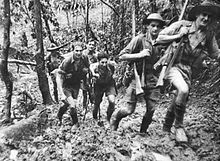30th Brigade (Australia)
| 30th Brigade (Australia) | |
|---|---|
Second World War
| |
| Commanders | |
| Notable commanders | Selwyn Porter |
| Insignia | |
| Headquarters unit colour patch |  |
The 30th Brigade was a
History
The brigade was raised as a
Following its arrival in New Guinea, the brigade was initially employed in establishing defences around Port Moresby. The beach defences between Bootless Inlet and Tupuselei were expanded, and the 39th Battalion relieved elements of the 49th around 7-mile Drome. Meanwhile, the 13th Field Regiment's guns were assigned to beach defence. The 49th Battalion occupied the Pyramid Point – Ela Beach sector, and the 53rd Battalion occupied the Napa Napa Peninsula, relieving the

The
The 49th Battalion was relieved by the US 128th Infantry Regiment and the brigade redeployed to guard exfiltration points from the Sogeri Plateau, with elements around 17-Mile, Hombrom Bluff, the lower Goldie River, Merigeda Mission and Laloki Airfield.[2] As the tide of the Kokoda Track campaign turned in the Allies favour, the Japanese began withdrawing back towards Buna. In October 1942, the brigade was withdrawn back to Port Moresby where 53rd Battalion was amalgamated with the 55th Battalion to form the 55th/53rd Battalion.[6] After this, the brigade undertook garrison duties and further training in Port Moresby before taking part in the liberation of Gona and Sanananda during the Battle of Buna–Gona. It was committed to the fighting in December 1942 when the 39th Battalion was dispatched to Gona, and the 49th and 55th/53rd Battalions reinforced the Australian units that were fighting around Sanananda.[7]
In early 1943, the brigade was flown back to Port Moresby, prior to its return to Australia. for reorganisation. During this time, the
Attached units
Over the course of the brigade's existence, its order of battle changed a number of times as various infantry battalions were force assigned or reallocated to other brigades. The following units were attached at various times:[10]
Commanding officers
The following officers commanded the 30th Brigade:[11]
- Brigadier Neville Hatton
- Brigadier Selwyn Porter
Notes
- ^ https://s3-ap-southeast-2.amazonaws.com/awm-media/collection/RCDIG1024643/bundled/RCDIG1024643.pdf
- ^ a b c d e f g h i McKenzie-Smith (2018), p. 2114.
- ^ a b Austin (1988), p. 19.
- ^ a b Keogh (1965), p. 157.
- ^ "39th Battalion (Hawthorne–Kew Regiment)". Second World War 1939–1945 units. Australian War Memorial. Archived from the original on 15 March 2011. Retrieved 4 January 2011.
- ^ "53rd Battalion (West Sydney Regiment)". Second World War 1939–1945 units. Australian War Memorial. Archived from the original on 15 March 2011. Retrieved 13 November 2009.
- ^ Brune (2004), p. 560.
- ^ a b "3rd Battalion (The Werriwa Regiment)". Second World War 1939–1945 units. Australian War Memorial. Archived from the original on 15 March 2011. Retrieved 13 May 2009.
- ^ Dexter (1961), p. 17.
- ^ "30 Australian Infantry Brigade: Unit Subordinates". Orders of Battle.com. Archived from the original on 6 July 2007. Retrieved 2 January 2010.
- ^ "30 Australian Infantry Brigade: Appointments". Orders of Battle.com. Retrieved 2 January 2010.[permanent dead link]
References
- Austin, Victor (1988). To Kokoda And Beyond – The Story of the 39th Battalion 1941–1943. Carlton, Victoria: Melbourne University Press. ISBN 0-522-84374-3.
- Brune, Peter (2004). A Bastard of a Place: The Australians in Papua. Crows Nest, New South Wales: Allen & Unwin. ISBN 978-1-74114-403-1.
- Dexter, David (1961). The New Guinea Offensives. Australia in the War of 1939–1945. Series 1 – Army. Vol. VI. Canberra, Australian Capital Territory: OCLC 2028994.
- OCLC 7185705.
- ISBN 978-1-925675-146.
